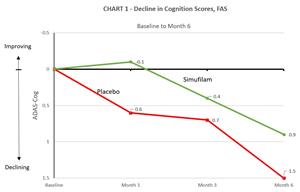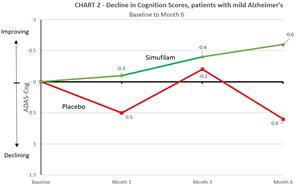Oral Simufilam Slowed Cognitive Decline in a Randomized Withdrawal Trial of Mild-to-Moderate Alzheimer’s Disease
- Simufilam Slowed Cognitive Decline by 38% Versus Placebo Over 6 months in Patients with Mild-to-Moderate Alzheimer’s Disease.
- Drug Effects Favored Mild Alzheimer’s Disease.
- In Mild Alzheimer’s, Simufilam Improved Cognition Scores Over 6 Months.
- In Mild Alzheimer’s, Simufilam Stabilized Cognition Scores Over 18 Months.
- Oral Simufilam Continues to be Safe, Well Tolerated.
In this double-blind, placebo-controlled, randomized study, all patients first received open-label simufilam 100 mg for 12 months; patients were then randomized (1:1) to receive either simufilam 100 mg or placebo for 6 months. 16 U.S. clinical sites participated. The CMS had one pre-specified cognitive endpoint: mean change in ADAS-Cog11 scores over 6 months, drug versus placebo.
Simufilam treatment for 6 months slowed cognitive decline by 38% compared to placebo in mild-to-moderate Alzheimer’s disease (MMSE 16-26). The placebo arm declined 1.5 points on ADAS-Cog, and this arm declined at all measured timepoints. The simufilam arm declined 0.9 points on ADAS-Cog, a 38% difference in favor of drug at month 6 (95% CI, – 2.1 to 1.0; not significant for sample sizes). See Table 1 and Chart 1.
Table 1: Results of Randomized Withdrawal Study – cognitive change, full analysis set (FAS)
| Full Analysis Set | Simufilam 100 mg (N = 78) |
Placebo (N = 77) |
Numerical Difference | Percent Difference |
| 6-month Change in ADAS-Cog |
0.9 point Decline |
1.5 point Decline |
– 0.6 | 38% in favor of drug |
Upon randomization into the CMS, mean baseline MMSE scores were 18.6 and 18.1 for the simufilam and placebo arms, respectively. Mean baseline ADAS-Cog scores were 19.3 and 21.9 for the simufilam and placebo arms, respectively.
“Monoclonal antibody drugs have slowed cognitive decline by 35% or less in early Alzheimer’s patients in large Phase 3 trials over 18 months,” said
Simufilam Drug Effects Favored Patients with Mild Alzheimer’s Disease.
Simufilam treatment for 6 months slowed cognitive decline > 200% compared to placebo in mild Alzheimer’s disease. CMS patients with mild Alzheimer’s (MMSE 21-26) on placebo declined 0.6 points on ADAS-Cog over 6 months as a group. CMS patients with mild Alzheimer’s on simufilam improved 0.6 points over 6 months as a group, a 205% difference in favor of drug (95% CI, – 2.6 to 0.4; not significant for sample sizes). See Table 2 and Chart 2.
Table 2: Results of Randomized Withdrawal Study – cognitive change, mild patients
| Mild Patients | Simufilam 100 mg (N= 40) |
Placebo (N= 36) |
Numerical Difference | Percent Difference |
| 6-month Change in ADAS-Cog |
0.6 point Improvement |
0.6 point Decline |
– 1.1 | 205% in favor of drug |
“Patients started out taking open-label simufilam for 12 months prior to enrolling in the CMS,” said
Upon randomization into the CMS, mean baseline MMSE scores for mild patients were MMSE 24.0 and MMSE 24.1 for the simufilam and placebo arms, respectively. Mean baseline ADAS-Cog scores for mild patients were 11.0 and 11.2 for the simufilam and placebo arms, respectively.
Simufilam for 18 months stabilized cognition in mild Alzheimer’s disease.
After taking open-label simufilam for 12 months, 76 patients with mild Alzheimer’s disease (MMSE 21-26) enrolled in the CMS and were randomized to receive either simufilam (N=40) or placebo (N=36) for 6 months. Mild patients randomized to simufilam in the CMS showed no material decline in ADAS-Cog scores over 18 months as a group, indicating stable cognition. Mild patients randomized to placebo in the CMS (and therefore withdrawn from simufilam treatment for 6 months) declined by 0.8 points in ADAS-Cog as a group. See Figure 1.
Figure 1. Historical declines on ADAS-Cog over 18 months in Alzheimer's disease (MMSE 20-30), placebo arms vs simufilam treatment.1 Notes: results shown for CLARITY P3 trial of lecanemab; EMERGE and ENGAGE P3 studies of aducanumab; and TRAILBLAZER P3 trial of donanemab; in this figure, the CMS is referred to as the ‘PTI-125-04’ study; ‘Simufilam100mg-Simufilam100mg’ refers to patients who received simufilam in both the open-label phase and the CMS; ‘Simufilam100mg-Placebo’ refers to patients who received simufilam in the open-label phase and placebo in the CMS.
Safety Data
Simufilam 100 mg twice daily was safe and well tolerated in this study. There were no drug-related serious adverse events. No treatment-emergent adverse events (TEAEs) occurred in 5% or more of study participants in the CMS.
Discussion
The CMS was a randomized withdrawal study. Patients who completed 12 months of open-label simufilam treatment were all invited to participate in the CMS. It is not known how long a washout period may be needed to remove lingering drug effects, if any, from prior treatment with open-label simufilam for 12 months.
In this small study of oral simufilam in patients with mild-to-moderate Alzheimer’s disease, the pre-specified cognitive endpoint showed a 38% decline in ADAS-Cog over six months in favor of simufilam, with good drug safety. Effects were pronounced in mild patients. Mean baseline MMSE and ADAS-Cog scores were approximately balanced given the small size of each arm.
Analysis of Efficacy Endpoints
The pre-specified cognition endpoints were analyzed by
Chain of Custody for Clinical Data
Investigator sites collected clinical data from study participants. Sites entered their clinical data directly into an electronic data capture system managed by an independent, outside data management vendor. The data management vendor also maintains the clinical database. The data management vendor transmitted the clinical database directly to
Study Limitations
The CMS is a proof-of-concept study involving a small number of patients and limited data. Top-line clinical CMS results do not constitute, and should not be interpreted as, regulatory evidence of safety or efficacy for simufilam in Alzheimer’s disease. Rigorous evidence for drug safety and efficacy is derived from one or more large, randomized placebo-controlled Phase 3 studies. The limited size of the CMS may introduce clinical or statistical bias or may generate results that may not fully distinguish between drug effects and random variation. Different methods of statistical analysis on clinical data from the same study may lead to objectively different numerical results. These and other statistical and clinical features of our CMS study add complexity or limitations to the scope of data interpretation. In addition, ‘Top-line data’ is a summary of the clinical data prior to the completion of a full and final audit or quality-control of the clinical database. We are communicating top-line data so that stakeholders may have timely access to a summary of the CMS findings prior to us receiving the final dataset. Final data may change from today’s top-line data.
On-going Phase 3 Studies with Simufilam
Patient enrollment is expected to be completed for both Phase 3 studies by yearend 2023.
About Simufilam
Simufilam is Cassava Sciences’ proprietary, small molecule (oral) drug candidate that restores the normal shape and function of altered filamin A (FLNA) protein in the brain.
About
For more information, please visit: https://www.CassavaSciences.com
For More Information Contact:
(512) 501-2450
ESchoen@CassavaSciences.com
Cautionary Note Regarding Forward-Looking Statements:
This news release contains forward-looking statements, including statements made pursuant to the safe harbor provisions of the Private Securities Litigation Reform Act of 1995, relating to: the design, scope, conduct or intended purpose of our randomized withdrawal study or Phase 3 program of simufilam in patients with Alzheimer's disease; the ability of simufilam to provide patients with drug effects; the apparent ability of simufilam to favor patients with mild Alzheimer’s disease; the safety or tolerance of simufilam in the CMS clinical trial; our current expectations regarding timing of and the target patient enrollment numbers for our Phase 3 studies; any expected clinical results of Phase 3 studies; the treatment of people with Alzheimer’s disease dementia; the safety or efficacy of simufilam in people with Alzheimer’s disease dementia; comments made by our employees regarding simufilam, drug effect, and the treatment of Alzheimer’s disease; and potential benefits, if any, of our product candidates. These statements may be identified by words such as “may,” “anticipate,” “believe,” “could,” “expect,” “would”, “forecast,” “intend,” “plan,” “possible,” “potential,” and other words and terms of similar meaning.
Simufilam is our investigational product candidate. It is not approved by any regulatory authority in any jurisdiction and its safety, efficacy or other desirable attributes have not been established in patients.
Drug development involves a high degree of risk, and only a small number of research and development programs result in regulatory approval and commercialization of a product. Clinical results from our prior studies may not be indicative of results of future or larger scale clinical trials and do not ensure regulatory approval. You should not place undue reliance on these statements or any scientific data we present or publish.
Such statements are based largely on our current expectations and projections about future events. Such statements speak only as of the date of this news release and are subject to a number of risks, uncertainties and assumptions, including, but not limited to, those risks relating to the ability to conduct or complete clinical studies on expected timelines, to demonstrate the specificity, safety, efficacy or potential health benefits of our product candidates, any unanticipated impacts of inflation on our business operations, and including those described in the section entitled “Risk Factors” in our Annual Report on Form 10-K for the year ended
This news release may also contain statistical data and drug information based on independent industry publications or other publicly available information. We have not independently verified the accuracy or completeness of the data contained in these publicly available sources of data and information. Accordingly, we make no representations as to the accuracy or completeness of such data or information. You are cautioned not to give undue weight to such data.
The content of this presentation is solely our responsibility and does not represent the official views of the
___________________________________
1 Figure 1: Forest plot by
Photos accompanying this announcement are available at
https://www.globenewswire.com/NewsRoom/AttachmentNg/c920d107-3c33-450a-b801-48b008614378
https://www.globenewswire.com/NewsRoom/AttachmentNg/35197b1c-ad89-4067-b692-2163afc22158
https://www.globenewswire.com/NewsRoom/AttachmentNg/bb23047a-5f15-4047-b402-c3cce6d70290

Source: Cassava Sciences, Inc.




